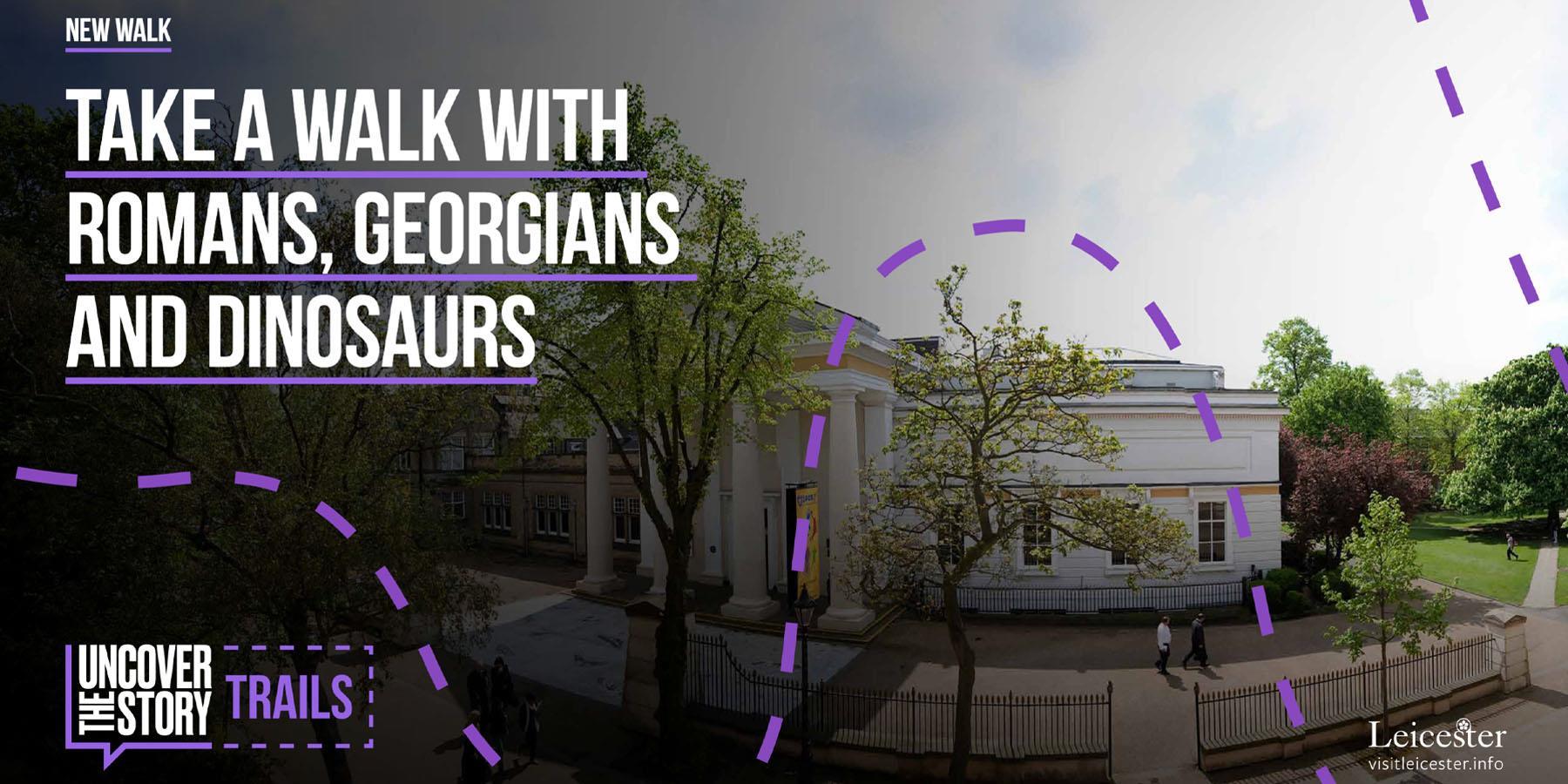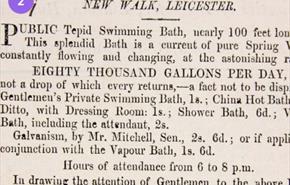Writers’ pavement -
Located on the northern end of New Walk outside Mattioli
Woods, New Walk Square, the Writers’ Pavement was
designed by Colin Hargrave and Roy Webb, carved by
Philip Langmead of Barham Stone Ltd and sponsored
by Cambridge & Counties Bank Ltd. The art piece
was commissioned by The Friends of New Walk to
commemorate Leicester’s contribution to the literary arts.
Leicester has a rich literary history with famous names
such as Joe Orton, Phillip Larkin, Christopher Hibbert,
Charles Percy Snow, E Phillips Oppenheim, Robert Burton,
Sue Townsend and Geoffrey Chaucer.
The Albion tepid baths -
The Albion Tepid Baths at 5 New Walk were built in the
1840s and used warm water provided by a sewing cotton
factory at No 32 King Street.
There were a variety of different bathing options offered
from the large swimming bath the public could access for
only one penny each which included a clean towel to private
bathing facilities.
The Baths and Washhouses Act was passed in 1846 to
encourage local authorities to build public baths and
washhouses by enabling them to take out loans.
Holy Cross Priory -
The first public building on New Walk was a Roman
Catholic chapel (1819) on the site of what is now Holy
Cross Priory.
Holy Cross was established as a priory in 1882. However, by
1929 the church proved too small for the congregation and
a famous preacher, Friar Vincent McNabb O.P set about
raising money for a larger church. Its foundation stone
was laid in 1929, the choir and transepts opened and the
high altar was consecrated in 1931. The church was finally
completed and consecrated in 1958.
There have been two church organs at the priory. The first
built by Leicester company, J Porritt & Son in 1861. It was
replaced in 1880 by a new, larger organ built by William
Ebenezer Richardson from Lancashire.
The Clicker -
The Clicker bronze sculpture by John Atkin was
commissioned by The Friends of New Walk
to commemorate the legacy of the Footwear
Industry in the city and county of Leicester.
The name Clicker comes from the name of the
operative who cut the skin leather against the
brass edges of the shoe patterns.
In 1853 Thomas Crick invented the process of
riveting soles to uppers and revolutionised the
trade. In 1918 Leicester became the national
and world centre for shoe technology and
design. The British United Shoe Machinery
Company and the British Shoe Corporation
employed thousands and were well known
nationally and internationally
Residential buildings -
Houses built at the lower end of New Walk in the 1820s
were the first on the walkway and were designed as
“genteel residences” for the families and servants of
businessmen and professionals. Development was
controlled to protect the public’s enjoyment of the
walkway. Houses had to be at least ten yards from the
Walk, fenced off by iron railings and there was no access
for carriages onto New Walk itself.
The houses around central New Walk date from 1850s
and 1860s and would have been homes of merchants,
manufacturers and professionals.
Last to be developed were the large Victorian houses of its
upper section dating from the 1880s. Many were designed
by the architect Stockdale Harrison reflecting the growing
prosperity of Leicester’s business and professional classes.
Leicester Museum & Art Gallery -
Designed in 1836 by Joseph Hansom, investor of the horse drawn cab,
this building started life as a Nonconformist Proprietary school.
In 1848 the school was bought by the Leicester Corporation with the idea
of converting it to a public museum, one of the first council-run museums
to be established in the country. It opened as a museum in 1849 and the
initiative was keenly supported by the town’s Literary and Philosophical
Society who donated its own collection of 10,000 objects to the project.
Sir David Attenborough was a regular visitor in his childhood having
grown up nearby. The museum has been expanded several times and has
remained free to visit since 1849.
When it opened in 1849 Thomas Cook thought it would become “an
instructive lounge for the lovers of science” and his son donated
specimens from his travels.
The clothier -
From the early 19th century to the end of the 20th
century the main industries in Leicester were hosiery,
footwear and engineering.
The Clothier is a marble statue by John Atkin
commissioned by The Friends of New Walk in 2010 to
commemorate the legacy of the clothing industry.
The development of steam-powered knitting machines
revolutionised the textile industry and created employment
in large firms such as Corah. The Corah hosiery factory
in St Margaret’s was the largest in Europe. Bentley
Engineering and Stibbes companies were highly successful
in manufacturing textile machinery
De Montfort Square -
The western side of New Walk was reserved for gardens
and squares. These are Museum Square, The Oval and
De Montfort Square. The Oval surrounded by ornate iron
railings was traditionally popular with children’s nannies.
De Montfort Square is named after Simon De Montfort,
Earl of Leicester, and is home to the statue of Robert Hall,
a 19th Century Baptist Minister. Designed by John Birnie
Philip and unveiled in 1871, the 9 feet statue made of white
Sicilian marble stands on a 12 feet pedestal of polished
granite. Hall was a great public speaker who campaigned
for better conditions for local hosiery workers.
St. Stephen’s united
Reformed church -
This 19th century church on the corner of De Montfort
Street and overlooking De Montfort Square was originally
built where Leicester Railway Station now stands. The
building was designed by architect James Tait. When the
present building replaced the earlier Campbell Street
Station in 1891, the church was moved stone by stone to its
New Walk location.
St Stephens was a Presbyterian church and became
United Reform when the Presbyterians merged with
the Congregationals.
Belmont Hotel -
Architect William Rushin designed 4 Belmont Villas which
was built between 1862–1865. The property was bought
by Josiah Gimson, owner of the Leicester engineering
company, Gimson & Co., who moved in with his family in
1870 and lived there until his death in 1883.
His son, Ernest Gimson became a renowned designer,
architect and craftsman. He was an important part of the
Arts and Crafts design movement.
4 Belmont Villas was sold in 1960 and is now part of
the Belmont Hotel. The blue plaque, celebrating
Ernest, was unveiled by his great nephew, Donald on
21 December 2009
De Montfort Hall -
Named after the sixth Earl of Leicester, Simon de
Montfort, De Montfort Hall was the first purpose-built
concert hall in Leicester. It was designed by local architect
Mr Shirley Harrison and opened in July 1913.
The Hall comprises a flexible auditorium that can be laid
out in different ways with a 400 to 2,200 capacity. The Hall
also houses an historic organ, donated by the industrialist
Mr Alfred Corah and is the only surviving example of a
large concert organ constructed by Leicester organ builders
Stephen Taylor and Son Ltd.
Notable artists who have appeared at De Montfort Hall
include Louis Armstrong, Frank Sinatra, The Beatles, The
Rolling Stones, Bob Dylan, David Bowie and Genesis.
Lutyens war memorial -
Renowned architect Sir Edwin Lutyens designed the
striking Arch of Remembrance in Victoria Park. It was built
as a memorial to those who died during the Great War and
was orientated to view the sunrise between the arches on
the 11th of November each year.
The cost of the Arch was £27,000, of which £10,000 was
provided by the people of Leicester. The Arch was officially
unveiled by two war widows on 3 July 1925 at a large and
well-attended ceremony.
Via Devana -
New Walk is a rare example of a Georgian pedestrian
promenade. Laid out by the Corporation of Leicester in
1785, the walkway was intended to connect Welford Place
with the racecourse (now Victoria Park) and is said to
follow the line of a Roman trackway, the Via Devana.
Originally named “Queen’s Walk” after Queen Charlotte,
consort of George III, it was eventually the popular name
of the “New Walk” that survived. Almost a mile long, New
Walk has been a Conservation Area since 1969, ensuring its
unique character is protected.


